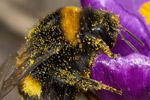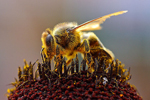The genus Bombus consists of over 250 species of large, nectar-loving bumblebees. Their bright coloration serves as a warning to predators that they are unwelcome prey and their bodies are covered in a fine coat of hair—known as pile—which gives them their characteristically fuzzy look. Bumblebees display a remarkably capable flight performance despite being encumbered with oversized bodies supported by relatively diminutive wings.
It is then striking that scientists have discovered some species of bumblebee occurring naturally as high as 5,600 m (~18,350 feet) in the Nepalese Himalayas. Curious about how these bees adapt to flight in rarefied and hypobaric (low pressure) atmospheres, and supported by a grant from National Geographic, Michael E. Dillon and Robert Dudley set out to test the aerodynamics of the alpine bees.
They captured six male bees of the species Bombus impetuosus from China at an elevation of 3,250 meters (~ 10,600 feet), and introduced them individually into a flight chamber. There, they carefully lowered the pressure of the chamber in increments corresponding to an increase in altitude of 500 m, noting the altitude at which the bees flew best and at which they experienced complete flight failure. They also analyzed flight pattern videos at various simulated altitudes, while taking careful measurements of the body weight and thorax sizes of each bee.
In their recent study published in the journal Biology Letters, Dillon and Dudley state “all bees successfully hovered at air pressure equivalents exceeding 7,400 m, three flew above 8,000 m, and two flew at air pressures corresponding to altitudes higher than the peak of Mt. Everest.”

A bumblebee pollinating a flower, with its characteristically stunted wings in relation to its body size. Photo credit: Alvesgaspar, published under a GNU FDL License.
Further study revealed that this striking phenomenon was demonstrated not by the bees’ increasing the frequency with which they flapped their wings, but by significantly increasing the angular extent of their wing motion.
Neither the temperature of the air nor individual body mass had any effect on the maximum flight altitude attained by each bee, but there was a slight indication that having larger thoracic mass (or enlarged midriffs) was an advantage.
These findings are particularly impressive due to the many difficulties that insects face when flying at high altitudes. Since forces produced by wing flapping are directly dependent and proportional to air density, the thin air at high altitudes produces a harsh reduction in the force required to balance the body weight of a flying insect. Further, the elevated metabolisms of flying insects require them to have the highest demand of oxygen for their body weights of any other avian creature. These bumblebees appear to have overcome these difficulties with aplomb.
The ability to rapidly adapt to changing altitudinal gradients, the authors suggest, could be used by males in long foraging runs across elevational gradients, or to produce the sudden bursts of speed required in mating behavior or in the avoidance of predators. The authors suspect that female bees, with smaller wings relative to body size, might not be capable of similar feats of aerodynamic flying but further study is required to ascertain the validity of this assumption.

Summit of Mount Everest. Photo by: Kimberly Casey/NASA/Creative Commons 2.0.
Citations:
- Dillon, M. E. and Dudley, R. 2014. Surpassing Mt. Everest: extreme flight performance of alpine bumble-bees. Biology Letters. http://dx.doi.org/10.1098/rsbl.2013.0922
- Willams, P.H., Ito, M., Matsumura, T. and Kudo, I. 2010. The bulblebees of the Nepal Himalaya (Hymenoptera: Apidae). Insecta Matsumurana Ser. Entomol. New Ser. 66, 115-151.
Related articles
Bee-harming pesticides may impact human nervous system
(12/23/2013) Neonicotinoid pesticides, which have been increasingly blamed for the collapse of bee populations, may also impact human’s developing nervous system, according to a review of research by the European Food Safety Authority (EFSA). The EFSA says that current safety guidelines for two pesticides—acetamiprid and imidacloprid—may be too lax to protect humans, especially the developing brains of unborn children
Losing just one pollinator species leads to big plant declines

(07/22/2013) A shocking new study finds that losing just one pollinator species could lead to major declines in plant productivity, a finding that has broad implications for biodiversity conservation. Looking at ten bumblebee species in Colorado alpine meadows, two scientists found that removing a single bee species cut flower seed production by one-third. Pollinators worldwide are in major trouble as they are hit by habitat loss, pesticides, disease and other impacts. In fact, the EU has recently banned several pesticides that have been linked to the global bee decline.
EU labels another pesticide as bad for bees
(06/18/2013) A widely used insect nerve agent has been labelled a “high acute risk” to honeybees by the European Food Safety Authority (EFSA). A similar assessment by the EFSA on three other insecticides preceded the suspension of their use in the European Union.
U.S. loses nearly a third of its honey bees this season

(05/09/2013) Nearly a third of managed honeybee colonies in America died out or disappeared over the winter, an annual survey found on Wednesday. The decline—which was far worse than the winter before—threatens the survival of some bee colonies. The heavy losses of pollinators also threatens the country’s food supply, researchers said. The US Department of Agriculture has estimated that honeybees contribute some $20bn to the economy every year.
Europe bans pesticides linked to bee collapse
(04/29/2013) The EU has banned three neonicotinoid pesticides (imidacloprid, clothianidin and thiamethoxam) linked to the decline of bees for two years. The ban will apply to all flowering crops, such as corn, rape seed, and sunflowers. The move follows a flood of recent studies, some high-profile, that have linked neonicotinoid pesticides, which employ nicotine-like chemicals, to the widespread decline of bees seen both in Europe and North America.
Domesticated bees do not replace declining wild insects as agricultural pollinators

(04/03/2013) Sprinkled with pollen, buzzing bees fly from one blossom to another, collecting sweet nectar from brilliantly colored flowers. Bees tend to symbolize the pollination process, but there are many wild insects that carry out the same function. Unfortunately, wild insect populations are in decline, and, according to a recent study, adding more honey bees may not be a viable solution.
Common pesticides disrupt brain functioning in bees
(03/27/2013) Exposure to commonly used pesticides directly disrupts brain functioning in bees, according to new research in Nature. While the study is the first to record that popular pesticides directly injure bee brain physiology, it adds to a slew of recent studies showing that pesticides, especially neonicotinoids, are capable of devastating bee hives and may be, at least, partly responsible for on-going Colony Collapse Disorder (CCD).